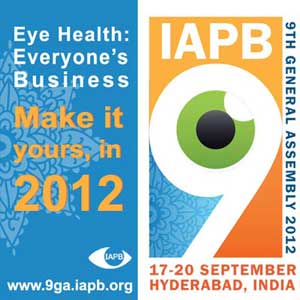IAPB, 9th General Assembly
Eye Health: Everyone’s Business
September 17-20, 2012 Hyderabad, India
– Part 2 –
- Barriers to cataract surgery:
- Unaffordable cost ( surgery / IOL , consultations, lab / EKG, transportation, accommodation, etc. ).
- Family concerns ( no one to accompany patient ).
- Logistic issues.
- Fear.
- Ignorance.
- Other diseases prevent cataract surgery.
- The 200,000 worldwide ophthalmologists are not adequate for future needs. Today 6 million cataract operations yearly. The number of persons over age 60 years is growing faster than the # of ophthalmologists. In many countries, 50% or more of the ophthalmologists do not perform cataract surgery.
- More blindness ( percentage ) secondary to corneal opacities/injuries ( unilateral and bilateral ) in the developing world.
- In some ocular surveys, the leading cause of blindness is cataracts and the second leading cause is blindness after cataract surgery. Monitoring surgical outcomes are important and were a major theme of this IAPB meeting. Surgical outcomes are important, just as important as CSR. Unfortunately, bad outcomes ( poor V.A. ) after cataract surgery are not uncommon. Good quality is essential to generate demand. Must not compromise quality. Basic minimum standards often lacking in developing the world. Monitoring and evaluation are important from the get to go.
- The Fred Hollows Foundation ( Australia ) and Price Waterhouse Cooper have demonstrated that the benefits of eliminating avoidable blindness and visual impairment far exceed the investment required. In developing countries, the estimated benefits outweigh the costs by a multiple of 4.1. In addition, there were other benefits such as the substantial gains in quality of life for the patient and their caregivers ( families ). Quality of life improvements includes increased primary education for any children within that family, reduced extreme poverty, increased independence/self-esteem, improved social networks, and increased gender equality.
- The most dangerous animal in subSaharan Africa other than man is not the hippo, the lion, nor the elephant but rather the mosquito ( malaria, yellow fever, Dengue fever, lymphatic filariasis, and some viral encephalitides ).
- The World Bank has been involved in eye care and wants to do more. Cataract surgery has been identified by the World Bank as one of the most highly cost-effective strategies that can be offered in developing countries The transmission ( black fly ) of Onchoceriasis may be eliminated by 2025.
- Human resources are the most expensive part of any health care program.
- Vision 2020: The Right To Sight’s goal to eliminate avoidable blindness by 2020 will not be achieved by acting alone. Need to bridge the gap. One size will not fit all in implementing Vision 2020. Huge opportunity to work more closely with other health care developers/organizations. Pick your partners carefully.
- Do not take/send broken eye equipment to developing world countries. Make sure the equipment is working and ship spare parts of the most likely problems. Non – working equipment is often worthless as there is no one to repair the equipment ( bioengineer, handyman, etc. ), no spare parts, no warranty, no hard currency to purchase broken parts from overseas, etc. Send the manual of any equipment shipped.
- Results from Peru and Belize show that the standardization of knowledge in oxygen therapy for caregivers in the NICU decreased the number of RoP babies and also the RoP infants needing treatment. Currently, the prevalence of blindness from RoP is the highest in middle-income countries
- Many of the various ophthalmic non-government developmental organizations ( NGO’s ) gave update reports of what they were doing worldwide to eliminate avoidable ( neglected ) blindness. Also updates on prevention of blindness efforts in South Asia, subSaharan Africa, and Latin America.
- SAFE strategy for trachoma: Surgery ( tarsal rotation ), Antibiotics (azithromycin ), Face cleanliness/ washing, and Environmental improvement have had a tremendous impact on the reduction of trachoma. Currently 63 million treatments with azithromycin ( Pfizer ). The most active trachoma currently is in Africa. < WWW Trachomaatlas.org> for world map of trachoma. GET 2020: Global Elimination of Trachoma as a blinding disease by 2020.
- Don’t talk about blindness but vision. Talk positive, not negative
I know this might have been a little disjointed but hope some of my notes were useful
Peace,
Baxter McLendon

